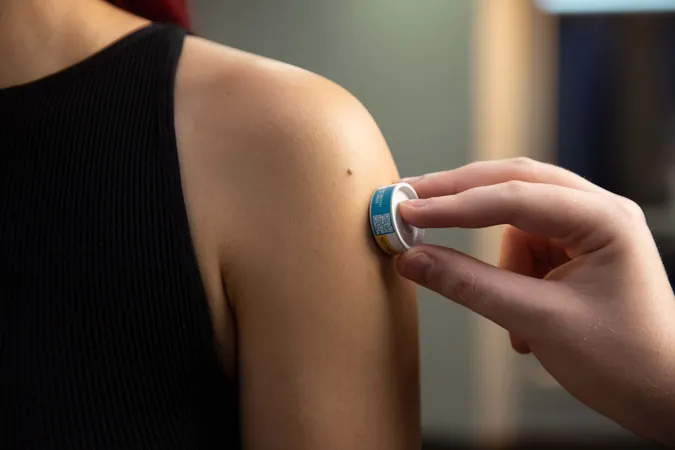
11 Needle-Free Vaccines Poised to Revolutionize Global Immunization Efforts!
2025-04-02
Author: Li
11 Needle-Free Vaccines Poised to Revolutionize Global Immunization Efforts!
The world of vaccination is on the brink of a significant transformation thanks to the innovation of microarray patches (MAPs). These needle-free, easy-to-administer devices could be game-changers in delivering vaccines, especially in low-income and pandemic-affected areas. According to Dr. Tiziana Scarna of Gavi, the Vaccine Alliance, MAPs have been dubbed the top priority for vaccine delivery innovations, with the potential to drastically improve vaccine coverage and equity in low- and middle-income countries.
Despite the promising potential of MAPs, a major challenge lies in the current lack of guidance on which vaccine patches would be most effective in terms of health impact. To address this shortcoming, the Vaccine Innovation Prioritisation Strategy (VIPS) Alliance—a collaborative initiative involving Gavi, WHO, the Gates Foundation, UNICEF, and PATH— has launched efforts to identify high-impact vaccine patches.
Easy and Effective: The Promise of Needle-Free Immunization
Microarray patches are small, sticker-like devices loaded with hundreds of tiny projections that can deliver vaccines directly into the skin's upper layers. Unlike traditional liquid vaccines which require constant refrigeration and skilled professionals for safe administration, MAPs can remain stable at room temperature for several days, making them easier to transport and use. This innovation could address one of the key barriers to immunization—vaccine hesitancy fueled by needle fears.
Dr. Birgitte Giersing, a key player in the vaccine prioritization efforts at WHO, emphasizes that MAPs can be transformative for equitable vaccine access in remote areas. Indeed, they are vital tools for reaching global immunization targets for diseases like measles, especially during times of heightened vaccine hesitancy.
A Strategic Approach to Championing MAPs
Identifying the right candidates for MAP development is critical. A five-year action plan published by the VIPS Alliance aims to accelerate this process. By establishing which vaccine patches are most beneficial for low-income nations, the research has focused on vaccines that will not only have the greatest public health impact but are also economically sustainable.
From an initial list of 91 vaccine targets, the VIPS Alliance narrowed it down to 11 promising candidates through rigorous evaluation of regulatory pathways, programmatic impacts, and financial prospects.
Meet the Top 11 Candidates for Vaccine MAPs Action!
The prioritized candidates have been organized into two groups. The first group consists of vaccines with high potential, such as:
- Hepatitis B
- Measles, Mumps, and Rubella (MMR)
- Human Papillomavirus (HPV)
- Rabies
- Yellow Fever
- COVID-19
- Seasonal and Pandemic Influenza
The second group includes vaccines targeting challenges such as:
- Group B Streptococcus (a leading cause of meningitis in newborns)
- Meningococcus (major causes of disease in sub-Saharan Africa)
- Typhoid Fever
- Pneumococcus (responsible for severe pneumonia)
Among these, the MAP for the measles-rubella vaccine is the furthest along in development. Preliminary studies in The Gambia indicate that it is not only safe but also effective, producing immune responses comparable to traditional injections. Manufacturer Micron Biomedical is now ramping up production in anticipation of further trials.
Other vaccine candidates, including those for influenza, COVID-19, and hepatitis B, have also shown promising results in recent clinical trials.
Looking Ahead: Overcoming Barriers to Rollout
Despite these advancements, there are numerous steps ahead before these innovative vaccines can be rolled out. The journey includes late-stage trials, national regulatory approvals, WHO prequalification, and necessary funding strategies. Collaboration among PATH and VIPS Alliance partners focuses on streamlining these processes, ensuring healthcare workers are adequately trained, and bolstering awareness to promote effective vaccine uptake.
These needle-free innovations are more than just a technological leap; they represent hope for a future where vaccination is accessible for everyone, regardless of geographic or economic barriers. The promise of MAPs could spell the difference between life and death for millions—ushering in a new age of public health. Stay tuned as we watch these groundbreaking developments unfold!




 Brasil (PT)
Brasil (PT)
 Canada (EN)
Canada (EN)
 Chile (ES)
Chile (ES)
 Česko (CS)
Česko (CS)
 대한민국 (KO)
대한민국 (KO)
 España (ES)
España (ES)
 France (FR)
France (FR)
 Hong Kong (EN)
Hong Kong (EN)
 Italia (IT)
Italia (IT)
 日本 (JA)
日本 (JA)
 Magyarország (HU)
Magyarország (HU)
 Norge (NO)
Norge (NO)
 Polska (PL)
Polska (PL)
 Schweiz (DE)
Schweiz (DE)
 Singapore (EN)
Singapore (EN)
 Sverige (SV)
Sverige (SV)
 Suomi (FI)
Suomi (FI)
 Türkiye (TR)
Türkiye (TR)
 الإمارات العربية المتحدة (AR)
الإمارات العربية المتحدة (AR)